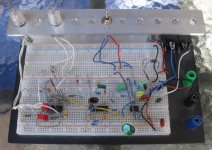Chuck D. Bones
Circuit Wizard
You can read about this on Runoff Groove. A nice OTA-based Phase-Shifter / Vibrato.
I built with this four minor mods:
1. I used a TL064 in place of two TL062s.
2. I added a THROB LED.
3. I replaced the back-to-back 10uF caps in the LFO with a pair of 2.2uF film caps in parallel.
4. I ditched the 10uF cap on the output of the Vref buffer. Loading an opamp with a large capacitor is bad practice and not necessary here.
Good vibrato and pseudo-UniVibe tones. Not quite as intense as a UniVibe, but pretty close. More headroom than the Grand Orbiter.
ROG, in their usual cleverness, designed an LFO that makes something close enough to a sinewave and then passes it thru an exponential converter to get just the right sweep. Unlike LDR and JFET-based phase shifters, there is nothing to select or tweak. This circuit is truly plug-n-play. I'm going to try adding another LM13700 to get four phase-shifter stages and see how that sounds.
Highly recommended.
Left knob: SPEED - Right knob: DEPTH.
LFO, exponentiator & Vref buffer on the left, phase-shifter OTAs in the middle, input buffer & mixer on the right.

I built with this four minor mods:
1. I used a TL064 in place of two TL062s.
2. I added a THROB LED.
3. I replaced the back-to-back 10uF caps in the LFO with a pair of 2.2uF film caps in parallel.
4. I ditched the 10uF cap on the output of the Vref buffer. Loading an opamp with a large capacitor is bad practice and not necessary here.
Good vibrato and pseudo-UniVibe tones. Not quite as intense as a UniVibe, but pretty close. More headroom than the Grand Orbiter.
ROG, in their usual cleverness, designed an LFO that makes something close enough to a sinewave and then passes it thru an exponential converter to get just the right sweep. Unlike LDR and JFET-based phase shifters, there is nothing to select or tweak. This circuit is truly plug-n-play. I'm going to try adding another LM13700 to get four phase-shifter stages and see how that sounds.
Highly recommended.
Left knob: SPEED - Right knob: DEPTH.
LFO, exponentiator & Vref buffer on the left, phase-shifter OTAs in the middle, input buffer & mixer on the right.






